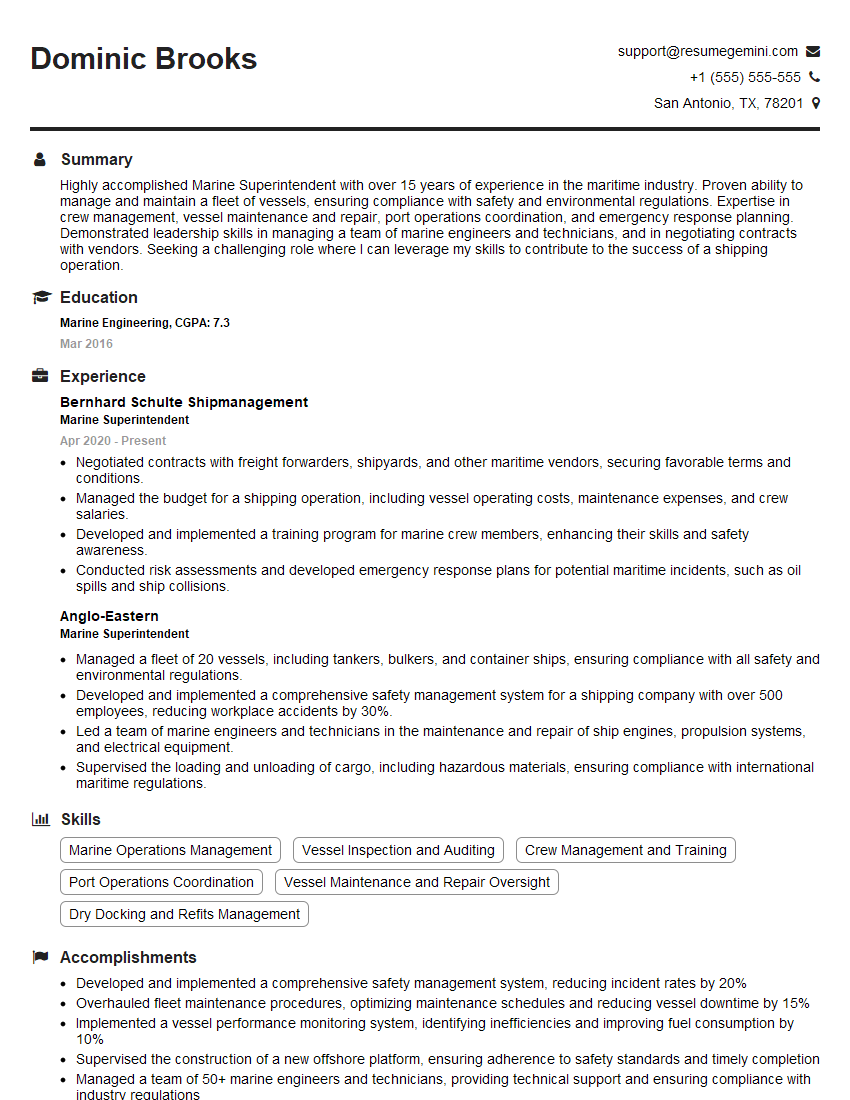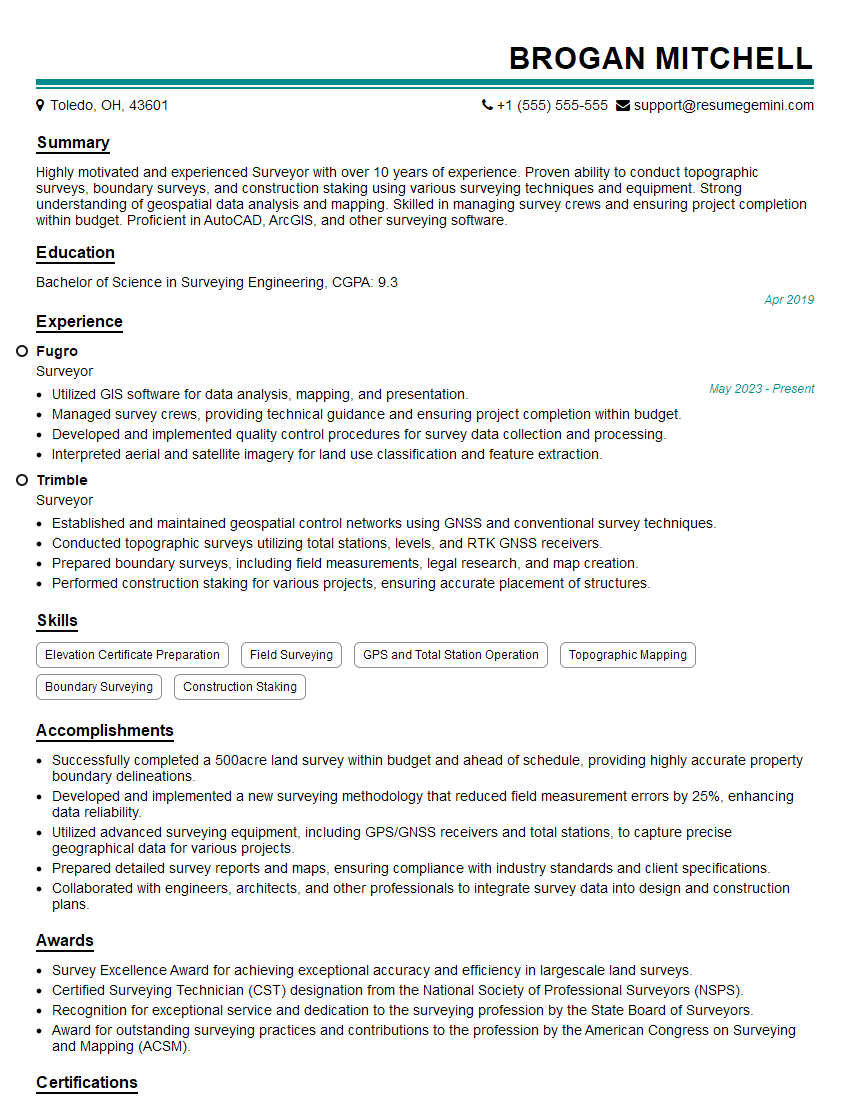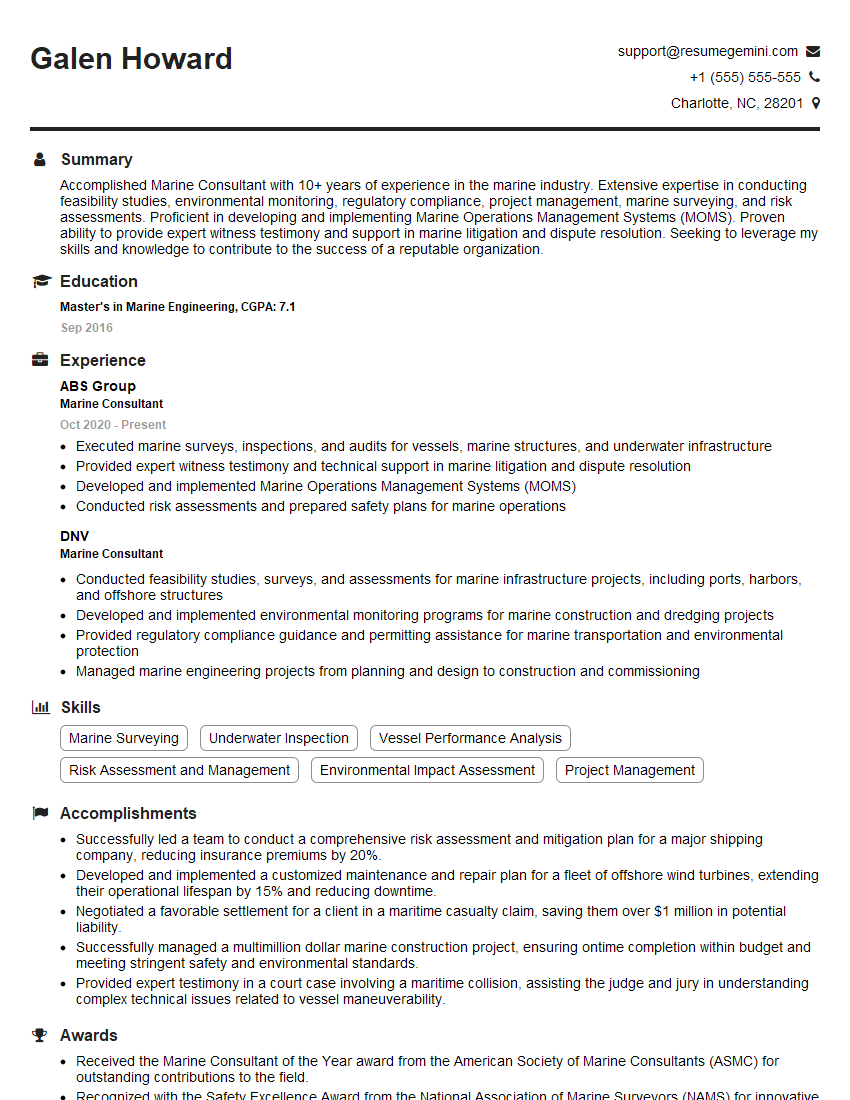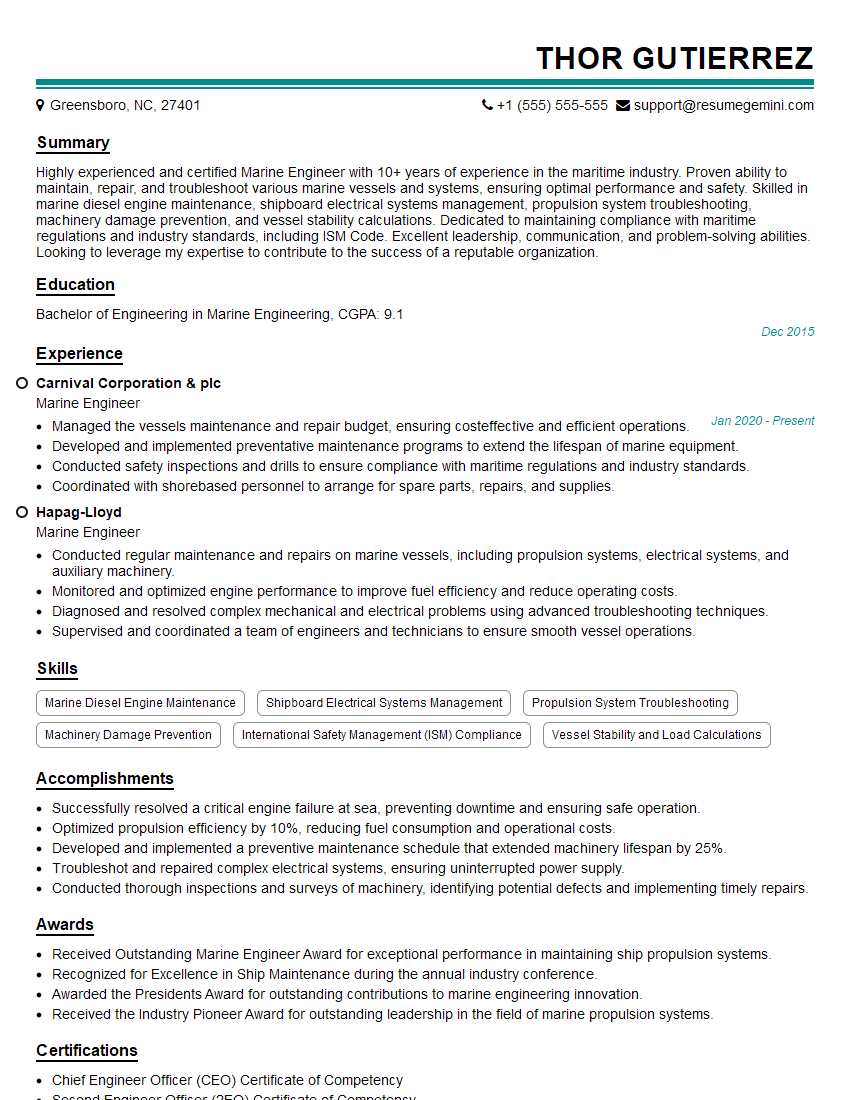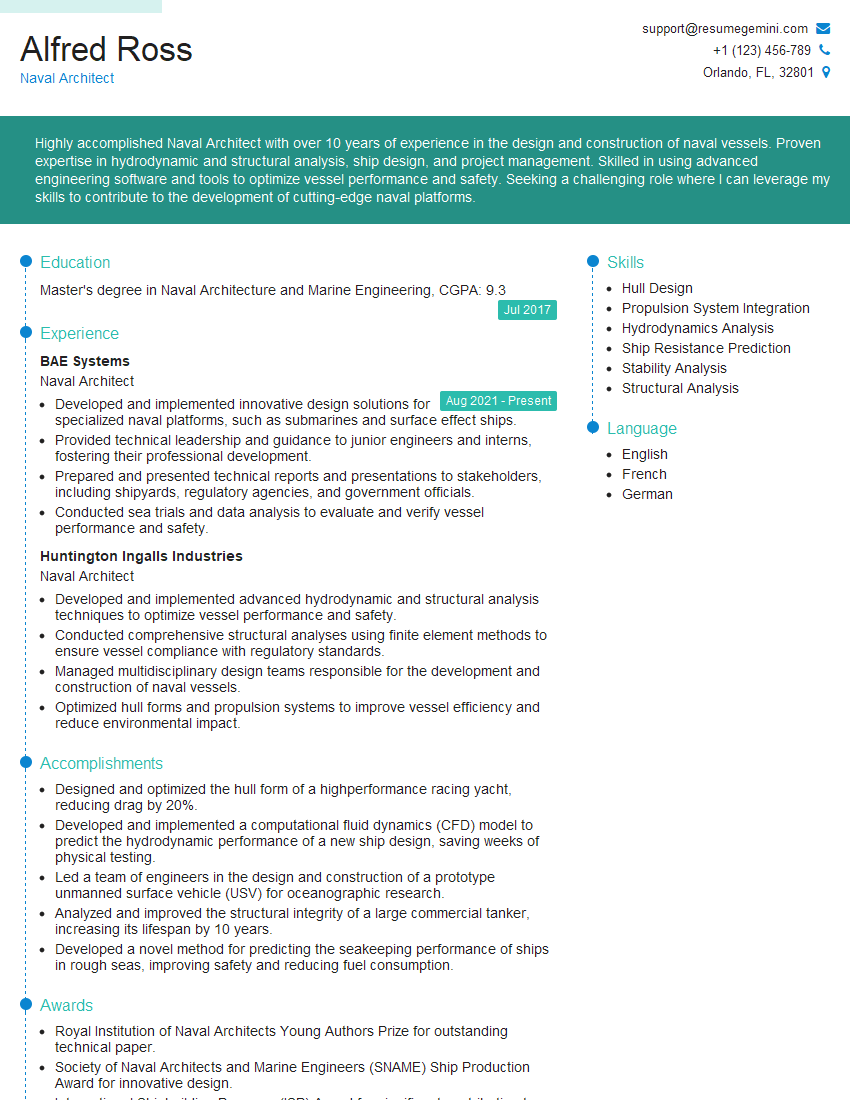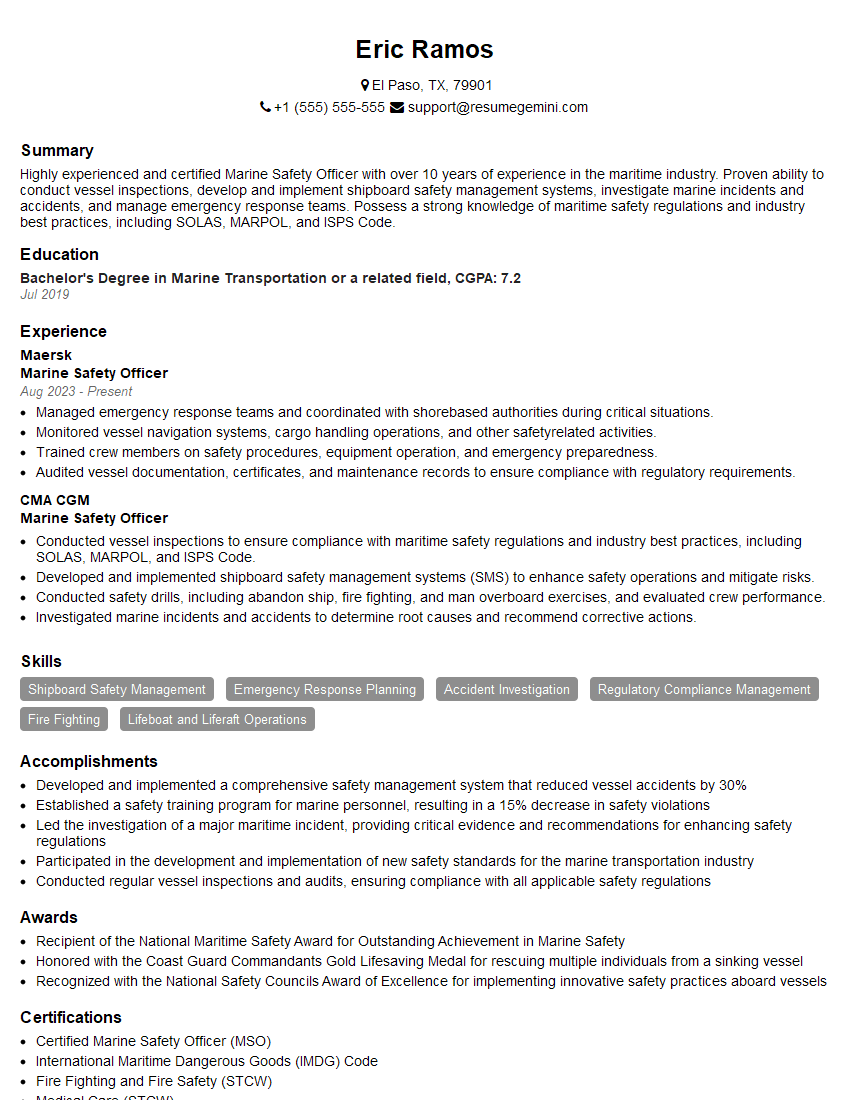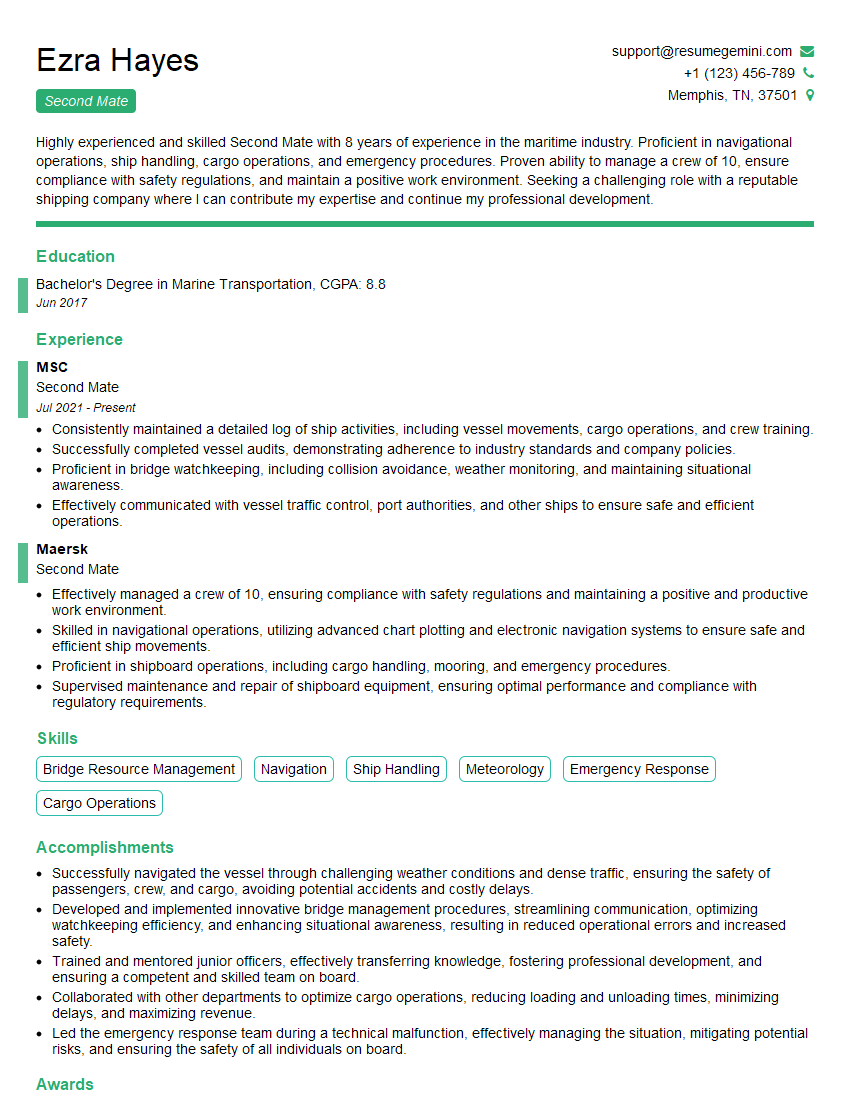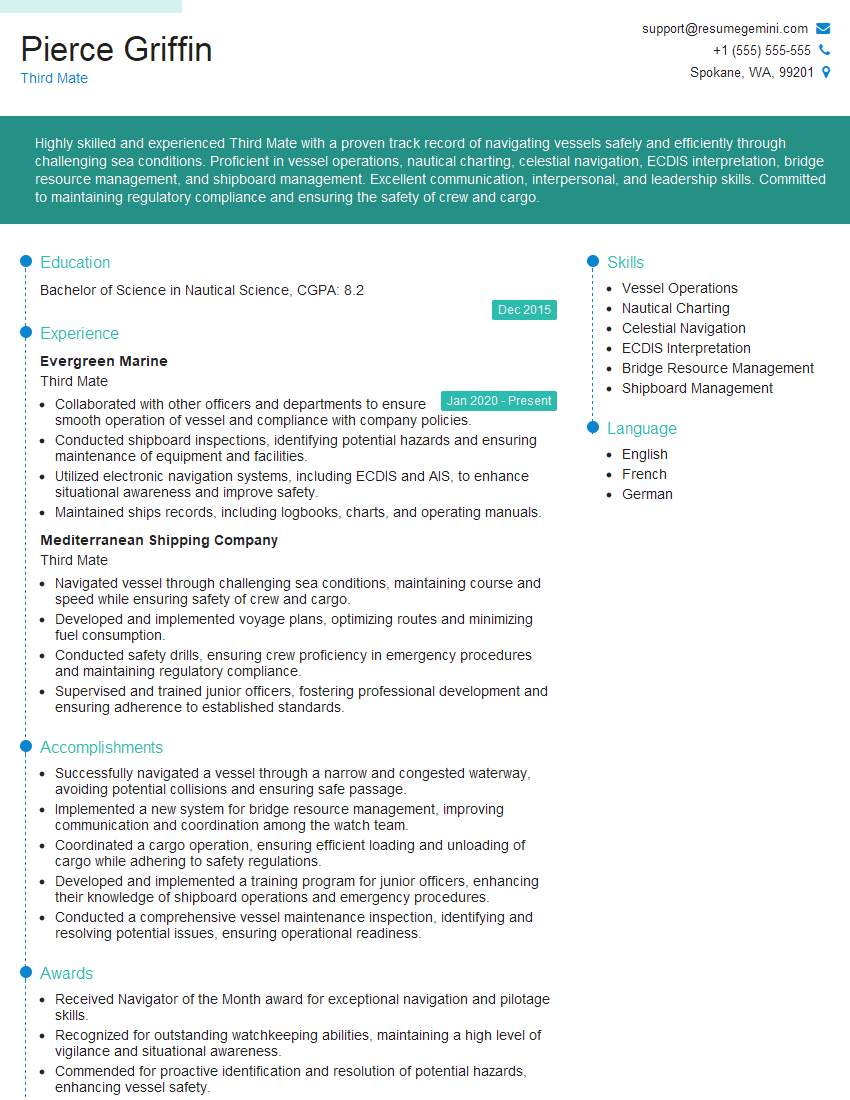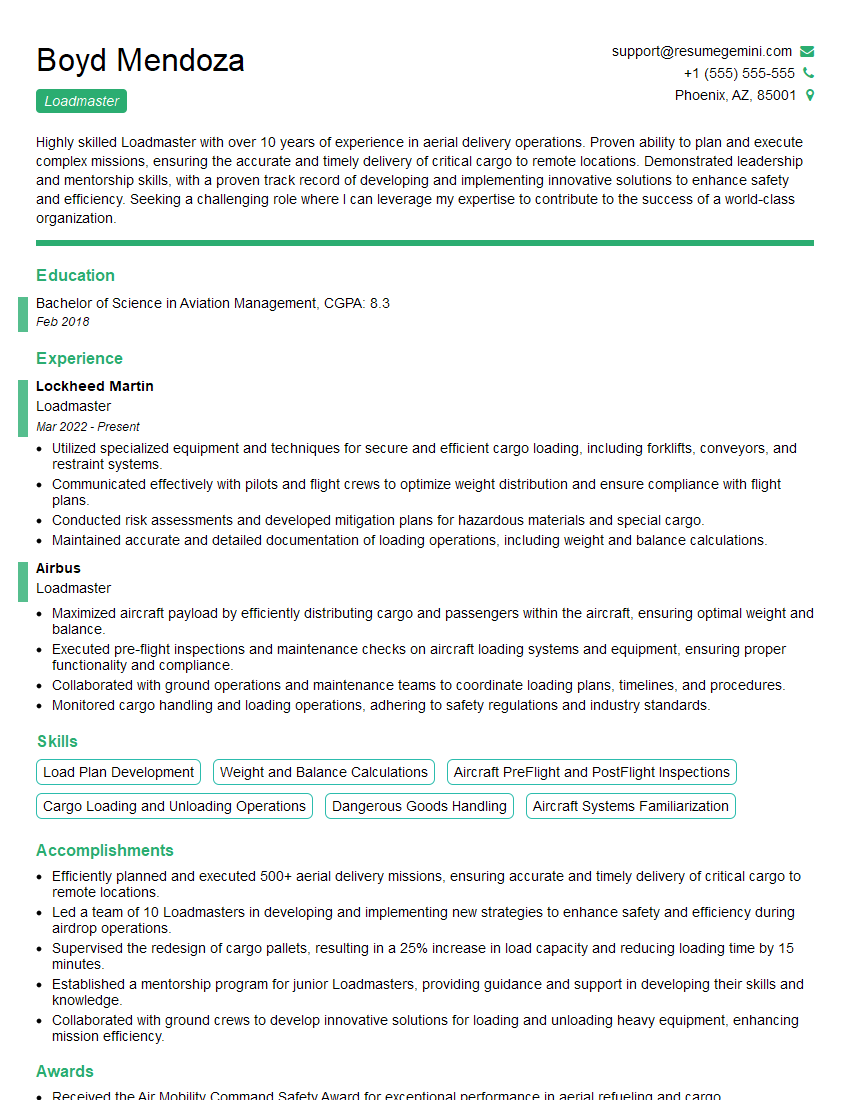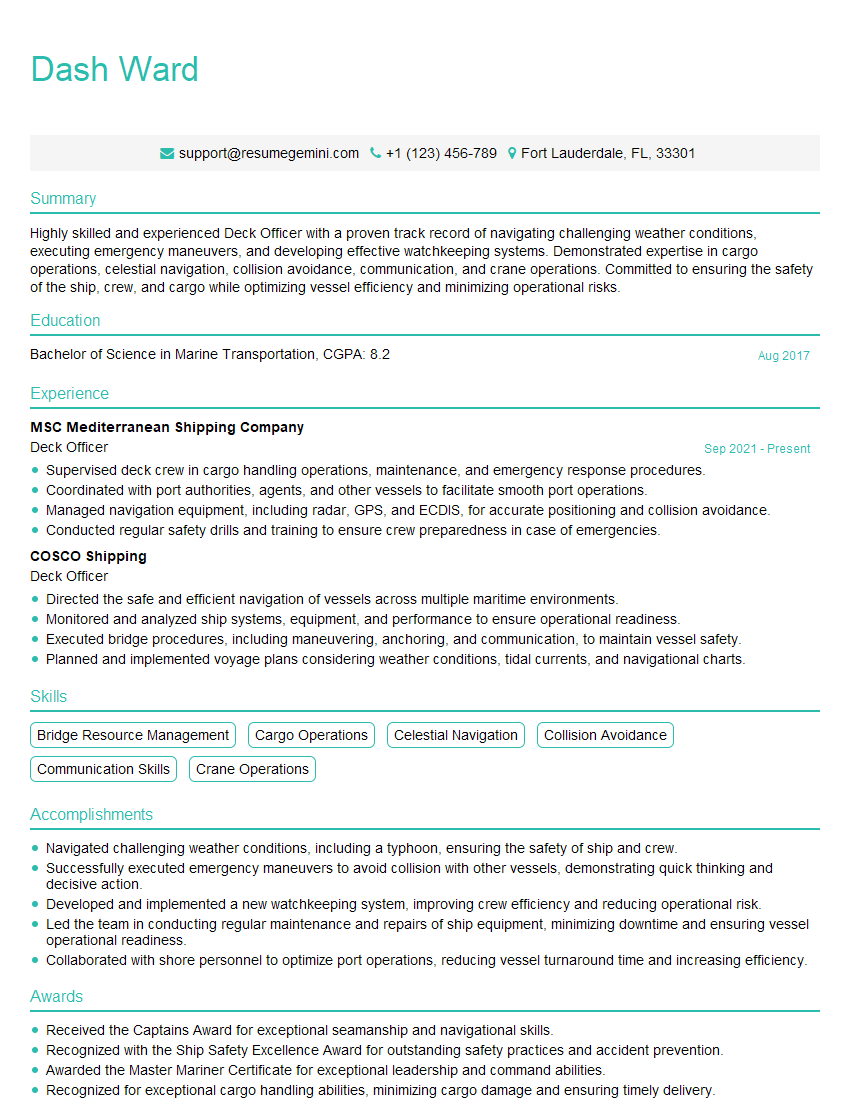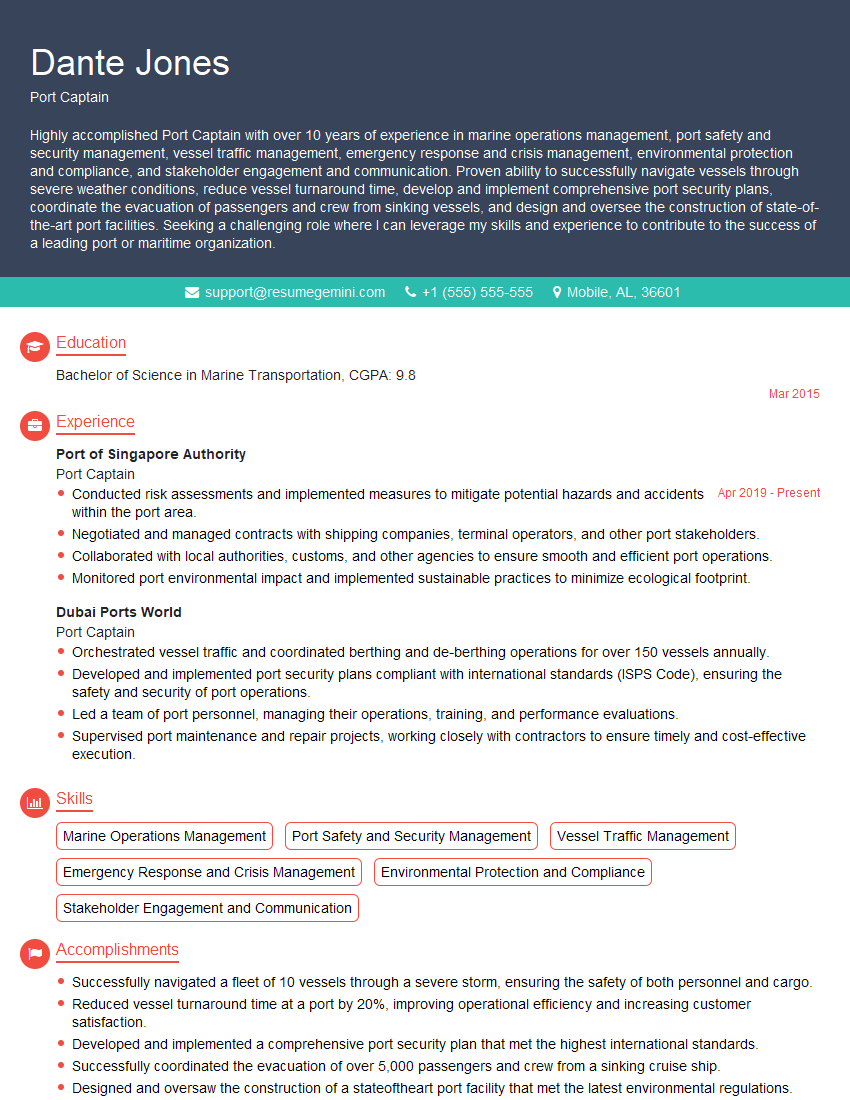Preparation is the key to success in any interview. In this post, we’ll explore crucial Ship Stability and Load Management interview questions and equip you with strategies to craft impactful answers. Whether you’re a beginner or a pro, these tips will elevate your preparation.
Questions Asked in Ship Stability and Load Management Interview
Q 1. Explain the principles of hydrostatic equilibrium.
Hydrostatic equilibrium describes the state where a floating body, like a ship, is at rest in a fluid (water). This means the buoyant force acting upwards on the ship is exactly equal to the ship’s weight acting downwards. Imagine a perfectly balanced scale; the weight on one side (the ship) is perfectly counterbalanced by the upward push of the water on the other. The center of buoyancy (B), which is the center of gravity of the underwater volume of the ship, is directly below the center of gravity (G) of the ship itself.
If these forces are not equal, the ship will either sink (weight exceeds buoyancy) or rise (buoyancy exceeds weight) until equilibrium is reached. This principle is fundamental to understanding ship stability because it forms the basis for how a ship floats and responds to external forces.
Q 2. Describe the factors affecting a ship’s stability.
A ship’s stability, its ability to remain upright and return to its upright position after being disturbed, is influenced by several key factors:
- Shape and form of the hull: A wider, deeper hull provides greater stability than a narrow, shallow one. Think of a wide-bottomed bowl versus a tall, thin glass; the bowl is far less likely to tip.
- Weight distribution (KG): The higher the center of gravity (G) of the ship, the less stable it is. Imagine stacking blocks on a toy truck; the higher the stack, the easier it is to tip.
- Buoyancy distribution (KB & B): The position of the center of buoyancy (B) changes as the ship heels (tilts). Its location relative to G heavily influences stability.
- Free surface effect: Liquids within the ship (fuel, water, ballast) that are not completely enclosed can significantly reduce stability. This is due to the shifting of the liquid’s center of gravity as the ship heels.
- Loading conditions: The distribution and amount of cargo directly impact KG and therefore stability. Incorrect cargo loading is a major cause of instability incidents.
- External factors: Waves, wind, and currents can also affect a ship’s stability.
Q 3. How do you calculate a ship’s center of gravity?
Calculating a ship’s center of gravity (KG) involves a systematic approach. It’s not a direct measurement but a calculated value obtained by considering the weight and vertical location of each component of the ship – hull, machinery, cargo, etc. This is often done using a tabular method.
Each component’s weight is multiplied by its vertical position relative to a convenient datum (a reference point). The sum of these moments (weight x position) is then divided by the total weight of the ship to find KG.
KG = Σ(Wi * hi) / ΣWi
Where:
Wi= weight of each componenthi= vertical position of each component’s center of gravity from the datumΣindicates summation across all components
This process requires detailed ship plans and a thorough inventory of all weights onboard. Software packages are often used to streamline this calculation.
Q 4. Explain the importance of the metacentric height (GM).
Metacentric height (GM) is the crucial measure of a ship’s initial static stability. It’s the distance between the center of gravity (G) and the metacenter (M). The metacenter is a theoretical point where the lines of action of buoyant force intersect as the ship heels through a small angle. A larger GM indicates greater initial stability.
GM determines the ship’s resistance to heeling. A positive GM implies that when the ship is heeled slightly, the buoyant force will create a righting moment that tends to restore the ship to its upright position. A negative GM implies an unstable condition where any slight heel will lead to further capsizing.
In practice, a sufficient GM ensures a ship can withstand moderate external forces and maintain its equilibrium. The required GM varies depending on the ship’s type and intended operating conditions. For example, passenger ships typically require a larger GM compared to cargo vessels.
Q 5. What are the different methods for determining a ship’s KG?
Several methods exist for determining a ship’s KG:
- Light ship KG: Obtained from the shipbuilder’s plans, this value represents the KG of the vessel without cargo or stores. It is a key baseline figure.
- Inclining experiment: A precise method involving slightly heeling the ship and measuring the shift in the pendulum. This allows calculation of KG. This requires careful measurements and planning and is commonly done before a ship enters service.
- Calculations based on loading information: Once cargo is loaded, weight and location data of all onboard items are meticulously collected and utilized in the KG calculation formula, as described earlier.
- Use of onboard sensors: Modern ships may use advanced sensors to continuously monitor weight distribution and estimate KG in real-time. This provides ongoing feedback on stability.
The accuracy of KG determination directly impacts the accuracy of other stability calculations and is paramount for safe operations.
Q 6. How do you assess the stability of a vessel in various loading conditions?
Assessing a vessel’s stability under various loading conditions requires a systematic approach using stability calculations and software. Key aspects include:
- Loading plans: Detailed plans outlining cargo stowage, including weight and location of each item, are essential. These plans should always adhere to the stability criteria outlined in the ship’s stability booklet.
- Stability calculations: Software and calculation methods (e.g., statical stability curves) are used to determine GM, righting levers, and other stability parameters for different loading scenarios.
- Intact stability criteria: International regulations stipulate minimum stability standards that must be met for various loading conditions. This is verified through calculations.
- Damage stability assessment: Calculations also need to consider the effects of potential damage (flooding) on stability, ensuring the ship can remain afloat even with compartment flooding.
By systematically analyzing different loading configurations and potential damage scenarios, we can ensure the vessel’s stability remains within safe limits throughout its voyage.
Q 7. Explain the concept of free surface effect and its impact on stability.
The free surface effect refers to the reduction in stability caused by the presence of partially filled tanks (fuel oil, water ballast, etc.). When a ship heels, the liquid within these tanks shifts, creating a horizontal force that acts to further increase the heel. This additional heeling moment reduces the effective GM and therefore the stability of the vessel.
Imagine a partially filled bathtub. If you tilt the tub slightly, the water will shift, further enhancing the tilt. This is analogous to the free surface effect. The larger the tank and the greater the free surface area (less full the tank is), the more significant the impact on stability. To mitigate the free surface effect, tanks should be either completely full or completely empty.
Proper loading procedures and careful consideration of free surface effect are crucial for maintaining adequate stability. This is especially vital for ships carrying large quantities of liquids.
Q 8. Describe the procedures for loading and unloading cargo to maintain stability.
Loading and unloading cargo requires meticulous planning to maintain ship stability. The primary goal is to distribute the weight evenly to prevent excessive list (tilt) or trim (difference in draft between bow and stern). This involves carefully considering the cargo’s weight, volume, and stowage location.
- Pre-loading planning: A detailed load plan is crucial, using software and considering the ship’s stability data to predict the effects of cargo placement. This plan dictates the sequence and position of each cargo item.
- Systematic Loading: Cargo is loaded in a methodical way, often starting with heavier items lower in the hold and strategically positioned to balance the ship. Regular checks using inclinometers and draft readings are critical.
- Monitoring and Adjustment: Throughout the loading process, the ship’s stability is continuously monitored. If imbalances are detected, adjustments such as shifting cargo or adding ballast water may be necessary to restore stability. This requires close communication between the loading crew, the ship’s officers, and the shore-based team.
- Unloading: Reverse procedure of loading, careful removal of cargo, and monitoring of stability throughout unloading. The unloading plan needs to consider the sequence to minimize imbalance and risk of instability.
Example: Imagine loading containers onto a vessel. Heavy containers should be placed low in the hold and distributed evenly across the ship. If you were to place all heavy containers on one side, it could lead to a significant list, potentially causing the vessel to capsize.
Q 9. What are the regulations governing ship stability and load management?
Regulations governing ship stability and load management are crucial for maritime safety. These are primarily set by the International Maritime Organization (IMO) and enforced nationally. Key regulations include:
- SOLAS (Safety of Life at Sea) Convention: This is the cornerstone of international maritime safety standards. It contains detailed regulations on cargo securing, load lines, stability information, and documentation.
- International Code for the Safe Carriage of Cargoes (Code of Safe Practice for Cargo Stowage and Securing): Provides detailed guidance on proper cargo securing techniques to prevent shifting during transit.
- Flag State Regulations: Each country where a vessel is registered (its flag state) has its own regulations, which generally align with IMO standards but may include additional requirements.
- Port State Control: When a ship enters a port, authorities can inspect the vessel’s documents and compliance with regulations. Non-compliance can lead to detention.
These regulations dictate the information included in the ship’s stability booklet, the requirements for load plans, and the responsibilities of the ship’s crew and cargo handlers. Failure to comply can lead to severe penalties and risks to the ship, crew, cargo, and environment.
Q 10. How do you interpret a stability booklet/data?
A stability booklet or data book is a crucial document for every vessel, providing information essential for safe loading and operation. Understanding its contents is paramount.
- Curves of Intact Stability: These curves graphically depict the ship’s stability characteristics at various loading conditions. They show the relationship between the angle of heel (list) and the righting lever (the force that restores the ship to upright).
- Cross Curves of Stability: These curves show the righting lever at different angles of heel and various displacement values (weight of the ship and cargo).
- Freeboard and Load Line Markings: These indicate the maximum permissible draft based on factors like season, cargo type, and region. Exceeding these limits severely compromises stability.
- Reserve Buoyancy: Information regarding the ship’s available buoyancy which is crucial to counter the effects of potential flooding.
- Damage Stability Criteria: Calculations showing the vessel’s ability to remain afloat after damage to its hull.
Interpreting the booklet requires a strong understanding of naval architecture and stability principles. It’s used in conjunction with load calculation software to determine safe loading configurations and to verify the vessel’s stability margin at each stage of loading and unloading.
Q 11. Explain the process of preparing a load plan.
Preparing a load plan is a critical step in ensuring a safe and stable voyage. It’s a systematic process that involves:
- Gathering Data: Collecting information about the vessel (from stability booklet), the cargo (weight, volume, stowage factors), and the voyage (route, environmental conditions).
- Selecting Cargo Stowage Locations: Using the vessel’s stability data and considering the weight and characteristics of each cargo item to allocate optimum locations.
- Weight Distribution: Strategically distributing the cargo’s weight to minimize list and trim and achieve a balanced distribution.
- Cargo Securing: Planning how to secure the cargo to prevent shifting during transit, following guidelines provided in the Code of Safe Practice for Cargo Stowage and Securing.
- Draft and Trim Calculation: Calculating the vessel’s draft (depth of the hull below the waterline) at the bow and stern to ensure it’s within safe limits.
- Stability Calculations: Verifying that the proposed load plan meets stability criteria, typically using specialized software.
- Documentation: Creating detailed documentation of the load plan, including cargo details, stowage positions, weight distribution, and stability calculations.
Example: A load plan for a container ship will specify the precise location of each container based on its weight and dimensions to achieve a balanced weight distribution. This prevents list and improves stability.
Q 12. What are the potential hazards associated with improper load management?
Improper load management poses significant hazards to ships and their crews.
- Capsizing: Uneven weight distribution can cause excessive list leading to capsizing, particularly in smaller or less stable vessels.
- Loss of Cargo: Inadequate securing can result in cargo shifting, causing damage and even loss overboard.
- Structural Damage: Excessive stress on the hull from uneven weight distribution can lead to structural damage.
- Water Ingress: Improper cargo stowage may compromise watertight integrity, leading to water ingress and potential sinking.
- Personnel Injury: Cargo shifting during transit can injure crew members working in the holds.
- Grounding and Collision: Improper trim (bow or stern down) can increase risk of grounding or collision, especially in shallow water.
The consequences can range from financial losses due to cargo damage or vessel repairs to catastrophic events like ship loss and loss of life.
Q 13. How do you handle stability issues during a voyage?
Handling stability issues during a voyage requires quick assessment and decisive action. The primary steps are:
- Assess the Situation: Determine the cause of the stability issue (e.g., cargo shift, water ingress). Use the vessel’s inclinometer and draft readings to quantify the list and trim.
- Implement Corrective Actions: If a cargo shift is detected, carefully plan and execute cargo shifting procedures (if safe and feasible). If water ingress occurs, initiate damage control procedures to contain the water and minimize its effect on stability.
- Reduce Speed and Change Course: Reducing speed minimizes the impact of waves and improves controllability. A change in course might be needed to alleviate stresses on the hull.
- Inform Authorities: Contact coastal authorities and/or the vessel’s management company to report the problem and receive guidance.
- Monitor Continuously: Closely monitor the ship’s stability and cargo conditions throughout the remainder of the voyage.
The ship’s Master is ultimately responsible for making critical decisions based on the situation and available resources. It is crucial to have a clearly defined emergency plan and well-trained crew.
Q 14. Describe the emergency procedures in case of stability problems.
Emergency procedures for stability problems vary depending on the nature of the problem but generally include:
- Abandon Ship: As a last resort, if the situation becomes critical and the vessel is in imminent danger of capsizing, an abandon ship order may be given.
- Damage Control: If water ingress is involved, activating the damage control team is crucial. This may involve sealing damaged compartments, pumping out water, and assessing the structural integrity of the vessel.
- Cargo Shifting Procedures: If cargo shifting causes instability, carefully planned cargo shifting procedures should be followed under the supervision of qualified officers.
- Emergency Ballasting: Adjusting ballast water to counteract list or trim if deemed safe and feasible.
- Mayday call: Issuing a Mayday distress call to alert nearby vessels and coast guard to the situation.
- Evacuation plan: Crew and passengers should be familiar with the evacuation plan to ensure a smooth, controlled exit in case of an emergency.
Regular drills are essential to ensure the crew is proficient in these procedures. Effective communication and coordination are crucial during any emergency situation.
Q 15. What is the role of trim and its impact on stability?
Trim refers to the difference in draft between the fore and aft ends of a vessel. A vessel is said to be ‘trimmed by the stern’ if the draft aft is greater than the draft forward, and ‘trimmed by the head’ if the draft forward is greater. Trim significantly impacts stability because it affects the vessel’s center of gravity (CG) and center of buoyancy (CB). A large trim can lead to a higher CG, reducing the vessel’s metacentric height (GM), which is a crucial indicator of initial stability. A smaller GM means the vessel is less stable and more prone to capsizing. Imagine a seesaw – a large trim is like shifting the weight significantly to one side, making it easier to tip over. Proper trim is crucial for safe and efficient operation, as it affects maneuvering, speed, and structural stresses on the hull.
For example, if a vessel is excessively trimmed by the stern, the increased stress on the stern could lead to structural issues. Conversely, excessive trim by the head might affect the vessel’s ability to navigate effectively and increase the risk of bow-diving in rough seas.
Career Expert Tips:
- Ace those interviews! Prepare effectively by reviewing the Top 50 Most Common Interview Questions on ResumeGemini.
- Navigate your job search with confidence! Explore a wide range of Career Tips on ResumeGemini. Learn about common challenges and recommendations to overcome them.
- Craft the perfect resume! Master the Art of Resume Writing with ResumeGemini’s guide. Showcase your unique qualifications and achievements effectively.
- Don’t miss out on holiday savings! Build your dream resume with ResumeGemini’s ATS optimized templates.
Q 16. Explain the concept of heel and list.
Heel and list both describe the inclination of a vessel from its vertical position, but they have different causes. Heel is a temporary and usually intentional inclination caused by external forces, like turning or wind. Think of a sailboat leaning into the wind – that’s heeling. It’s often self-correcting once the external force is removed. List, on the other hand, is a more permanent inclination resulting from an internal shift in weight, such as cargo shifting, flooding, or damage. A list is often not self-correcting and requires corrective action. A ship heeling slightly during a turn is expected, but a persistent list indicates a significant problem that requires immediate attention.
Imagine a perfectly balanced seesaw. A brief push on one side creates a heel, while placing a heavy weight unevenly on one side produces a list.
Q 17. How do you manage cargo shifting during a voyage?
Managing cargo shifting is paramount for maintaining ship stability throughout a voyage. The key strategies include proper stowage planning, securing methods, and regular monitoring. Before loading, a detailed plan should be created, considering cargo weight distribution, density, and the vessel’s characteristics. This plan should ensure the vessel’s CG remains within acceptable limits. During loading, cargo should be secured using appropriate methods (discussed in the next answer), and regular inspections should be conducted to detect any shifts. During the voyage, the crew should regularly monitor the vessel’s trim, list, and stability, adjusting cargo if necessary (within safe limits and with caution). The use of modern technology such as GPS-enabled load monitoring systems can help in tracking cargo movement in real-time and provide early warning of any potential issues. In case of a significant shift, the vessel may need to reduce speed or alter course to minimize the impact of the waves.
Q 18. What are the different types of cargo securing methods?
Various methods are employed to secure cargo, depending on its type and the vessel’s characteristics. These include:
- Lashing: Using strong ropes, chains, or straps to bind cargo to the deck or other secure points. This is common for containerized and other unit loads.
- Wedging: Placing wooden or other solid materials between cargo pieces to prevent shifting. This is often used for heavy or irregularly shaped items.
- Blocking and Bracing: Using blocks and strong timbers to support and restrict cargo movement. This is frequently used for heavy machinery or vehicles.
- Dunnage: Using materials like wood or other suitable materials to fill voids and create a stable platform for the cargo. This prevents shifting and damage.
- Container Securing: Using twist locks and other specialized equipment to secure containers on deck and in the holds.
The choice of securing method is determined by a risk assessment of the cargo and voyage conditions, ensuring it meets or exceeds international standards.
Q 19. Explain the importance of documentation in load management.
Thorough documentation is crucial in load management for several reasons. It provides a record of the loading process, cargo details (weight, dimensions, type), securing methods used, and the vessel’s stability information before and after loading. This documentation is essential for:
- Compliance: Demonstrating adherence to safety regulations and port state control requirements.
- Liability: Providing evidence in case of accidents or cargo damage claims.
- Auditing: Allowing for post-voyage analysis to improve loading procedures and identify potential weaknesses.
- Communication: Facilitating clear communication between various stakeholders (e.g., the master, cargo officers, and terminal operators).
This documentation should be meticulously maintained and readily accessible for inspection, including loading plans, stability calculations, securing diagrams, and inspection reports.
Q 20. How do you ensure compliance with SOLAS regulations regarding cargo securing?
Ensuring compliance with SOLAS (Safety of Life at Sea) regulations regarding cargo securing is paramount. This involves a multi-faceted approach:
- Training: Crew members must receive adequate training on proper cargo securing techniques and the relevant regulations.
- Planning: Detailed loading plans must be prepared, taking into account the vessel’s stability characteristics and the nature of the cargo.
- Inspection: Regular inspections of cargo securing arrangements must be carried out throughout the voyage.
- Documentation: Comprehensive records of the loading process, securing methods, and inspections should be maintained.
- Equipment: Using appropriate and certified cargo securing equipment.
- Emergency Procedures: Having well-defined procedures to address situations where cargo securing arrangements have failed.
Non-compliance can result in serious penalties, including detention of the vessel and potential legal action. Regularly auditing procedures and ensuring staff are up to date on the latest SOLAS requirements are vital.
Q 21. Describe the impact of weather conditions on ship stability.
Weather conditions significantly impact ship stability. High winds and waves create dynamic forces that can affect the vessel’s equilibrium. Strong winds can cause heeling, while large waves can induce rolling and pitching motions. These motions can lead to cargo shifting and even capsizing if the vessel’s stability is compromised. The size and frequency of waves, along with wind speed and direction, are major factors. Heavy seas can drastically increase the stress on the hull and reduce the effective GM, increasing the risk of instability. Masters need to adjust their vessel’s speed and course based on the prevailing weather conditions, often reducing speed to minimize the effects of wave action. They also need to monitor the vessel’s response to these conditions and take appropriate actions, which may include reducing cargo weight if deemed necessary.
For example, a vessel encountering a severe storm may need to reduce speed or seek shelter to minimize the risk of structural damage and ensure the safety of the crew and cargo.
Q 22. How do you calculate the effect of wind on a vessel?
Calculating the effect of wind on a vessel involves understanding that wind pressure creates a heeling moment, tending to tilt the ship. This is determined by the wind’s force, the vessel’s exposed area to the wind, and the lever arm (distance from the center of pressure of the wind force to the ship’s center of gravity). We can’t directly measure the wind’s effect on stability; instead, we calculate the heeling moment it creates and then assess its impact on the ship’s stability.
The calculation is usually done using the following formula:
Heeling Moment = Wind Pressure x Area x Lever ArmWind pressure is determined from the wind speed, usually using a formula incorporating the wind speed squared. The area is the projected area of the vessel above the waterline, presented to the wind. The lever arm is a crucial element and is measured from the center of effort of the wind pressure on the sail area to the vessel’s center of gravity (CG).
For example, imagine a cargo vessel with a large exposed area in a gale. The substantial wind pressure combined with the vessel’s height creates a significant heeling moment, requiring potentially immediate action to reduce the angle of heel, possibly by adjusting cargo or reducing speed.
More sophisticated calculations might involve considering the wind’s gustiness and direction relative to the ship’s heading, leading to dynamic changes in the heeling moment. Specialized software is often used for accurate calculations, taking into account the vessel’s specific characteristics and weather conditions.
Q 23. What is the significance of the righting lever and righting moment?
The righting lever (GZ) and righting moment (RM) are fundamental concepts in ship stability. Imagine tilting a toy boat; the righting moment is the force that tries to restore it to its upright position.
The righting lever (GZ) is the perpendicular distance between the ship’s center of gravity (G) and the center of buoyancy (B), the center of the underwater volume. It’s a key indicator of the ship’s stability; a larger GZ means a greater restoring force. This distance changes as the ship heels.
The righting moment (RM) is the actual force acting to return the ship to its upright position. It’s calculated as:
RM = Displacement x GZwhere displacement is the weight of the ship and its cargo. A large righting moment is crucial for safe operation. When the ship heels, the righting moment counteracts the heeling moment and prevents capsizing. A positive RM indicates a stable condition; a negative RM indicates instability and potential capsizing.
Imagine a sailing vessel; its stability is heavily influenced by its design and load distribution. The GZ and RM are critical parameters used in determining its stability at different angles of heel. A small GZ implies that even a slight external force (wind) can cause a large angle of heel and potentially capsize the vessel.
Q 24. Explain the use of stability curves and diagrams.
Stability curves and diagrams are graphical representations of a vessel’s stability characteristics. They provide a visual and readily understandable way to assess a ship’s stability at various angles of heel and load conditions.
The most common diagram is the GZ curve, which plots the righting lever (GZ) against the angle of heel. This curve shows how the righting force changes as the ship heels. A stable ship will have a positive GZ up to a significant angle of heel. A larger area under the GZ curve represents a higher degree of initial stability.
Other diagrams include the cross-curves of stability, which are a series of GZ curves for various displacement values. This allows for the analysis of stability under varying load conditions. Statical stability curves also display the righting moment (RM) against the angle of heel.
These diagrams are crucial for assessing the ship’s initial stability (resistance to small heeling moments), range of stability (the angle of heel to which the ship can recover), and maximum righting lever (the maximum righting force).
For example, a ship with a small area under its GZ curve might be more susceptible to capsizing in heavy seas, while a ship with a large area under the curve will offer greater resistance to heeling.
These curves provide essential information for determining load limits, assessing the risk of capsizing and are indispensable in determining safe operating limits of a ship.
Q 25. How do you assess the stability of a vessel in damaged condition?
Assessing the stability of a damaged vessel is complex and requires specialized knowledge. Damage can significantly alter the vessel’s geometry, affecting buoyancy and the position of the center of gravity. The assessment often involves considering various scenarios depending on the extent and location of the damage.
The process generally involves:
- Damage assessment: Determining the size, location, and type of damage (flooding, structural failure).
- Hydrostatic calculations: Recalculating the vessel’s buoyancy, center of buoyancy, and waterplane area to reflect the effects of flooding.
- Stability calculations: Using updated parameters in stability software to generate new stability curves for the damaged condition. This might involve using specialized software capable of accounting for flooded compartments.
- Intact stability comparison: Comparing the damaged condition stability characteristics to the vessel’s intact stability curves to determine the extent of stability reduction.
- Residual stability assessment: Analyzing the remaining righting moment and determining the ship’s ability to withstand further heeling or environmental forces.
For example, if a compartment is flooded, the vessel’s center of gravity (KG) will shift upwards, negatively affecting stability. The damage stability calculations will then help determine whether the ship can survive or if urgent actions like damage control, pumping, or lighterage are required.
Regulations like SOLAS stipulate requirements for damage stability calculations, and experienced naval architects and marine surveyors play a critical role in evaluating a ship’s stability post damage.
Q 26. What are the responsibilities of a Loadmaster?
A Loadmaster is responsible for the safe and efficient loading and unloading of cargo on a vessel. Their responsibilities encompass all aspects of cargo handling that impact the ship’s stability and safety.
Key responsibilities include:
- Cargo planning: Developing load plans that ensure safe and stable distribution of cargo.
- Stowage planning: Determining the optimal placement of cargo to maintain trim and stability, considering cargo type, weight, and characteristics.
- Stability calculations: Performing calculations and using stability software to verify that loading and unloading operations will not compromise the ship’s stability within safe limits.
- Documentation: Maintaining accurate records of cargo loading, weight distribution, and stability calculations.
- Supervision: Overseeing loading and unloading operations to ensure they conform to safety regulations and approved plans. They should also monitor the ship’s trim and heel throughout the loading process.
- Compliance: Ensuring compliance with all relevant international maritime regulations and codes related to cargo handling and stability.
In essence, the Loadmaster is the guardian of the ship’s stability and a crucial element in safe cargo operations. Their expertise prevents accidents caused by improper cargo handling.
Q 27. Describe the process of conducting a stability check before departure.
A stability check before departure is a critical step to ensure the vessel’s safety. It verifies that the ship is stable under the planned loading conditions and is capable of withstanding anticipated environmental conditions. This involves a rigorous process:
The process typically involves:
- Collecting data: Gathering information on the ship’s particulars (length, breadth, depth, etc.), cargo details (weight, type, stowage plan), and estimated environmental conditions (wind, waves).
- Stability calculations: Using stability software to calculate the ship’s KG (vertical center of gravity), transverse metacentric height (GM), and other stability parameters for the planned loading condition. These calculations determine the vessel’s righting levers at various angles of heel.
- Comparing to limits: Checking the calculated stability parameters against the ship’s approved stability criteria and limits. This often includes ensuring that KG doesn’t exceed allowable limits and GM meets minimum requirements for the specific loading condition and environmental factors.
- Assessing the effect of free surface: Calculating the impact of liquids in partially filled tanks on ship stability. This is important because a partially filled tank allows the liquid to ‘slosh’ and shift its center of gravity.
- Reviewing the loading plan: Ensuring the load plan incorporates proper stowage techniques and maintains adequate stability margins.
- Documentation: Compiling and reviewing all the necessary documentation to ensure that all calculations and evaluations are correct and are in compliance with regulations.
If any issues are detected, corrective actions such as shifting cargo or adjusting the loading plan are necessary before departure. This ensures that the ship is seaworthy and poses minimal risk of capsizing.
Q 28. How do you handle a situation where the calculated KG exceeds the permissible limit?
If the calculated KG exceeds the permissible limit, it indicates that the ship’s center of gravity is too high, reducing stability and increasing the risk of capsizing. This is a serious situation requiring immediate action.
The steps to handle this situation include:
- Verify the calculation: Double-check all the input data used in the KG calculation to ensure accuracy. Any minor errors in weights or locations of cargo can have a significant impact on the result.
- Review the loading plan: Examine the load plan to identify potential areas for improvement. This could involve repositioning heavy cargo to lower the CG, securing loose cargo or ballast to improve load distribution and reduce the ship’s KG.
- Consider lighterage: If other corrective actions prove insufficient, consider lighterage — offloading a portion of the cargo to reduce the ship’s overall weight and lower the KG. This might involve transferring cargo to lighter vessels or shore facilities.
- Communicate with relevant parties: Consult with the ship’s master, port authorities, and relevant stakeholders to coordinate actions for correcting the excessive KG. It might involve delay in departure until proper corrective measures are implemented.
- Document the process: Keep meticulous records of all calculations, actions taken, and communication with other stakeholders.
The goal is to bring the KG back within the acceptable limits to ensure the ship’s safe operation. Failing to do so could jeopardize the vessel and its cargo.
Key Topics to Learn for Ship Stability and Load Management Interview
- Archimedes’ Principle and Buoyancy: Understanding the fundamental principles governing floatation and stability.
- Center of Gravity (CG) and Center of Buoyancy (CB): Calculating and manipulating these crucial centers to ensure safe operation.
- Stability Criteria (GM): Mastering the calculation and interpretation of metacentric height (GM) and its significance in preventing capsizing.
- Load Line Regulations (Plimsoll Line): Understanding the legal requirements and implications for safe loading practices.
- Cargo Securing and Lashing Techniques: Practical knowledge of securing various cargo types to prevent shifting and maintain stability.
- Weight Distribution and Trim: Calculating and adjusting the weight distribution to achieve optimal trim and stability.
- Free Surface Effects: Understanding the impact of liquid cargo movement on stability and how to mitigate risks.
- Damage Stability: Assessing the ship’s stability in case of flooding or damage to compartments.
- Stability Software and Calculations: Familiarity with commonly used software and manual calculation methods.
- International Maritime Organization (IMO) regulations: Understanding relevant regulations and their practical application.
- Practical Case Studies and Problem Solving: Analyzing real-world scenarios to apply theoretical knowledge and develop problem-solving skills.
- Load Planning and Documentation: Understanding the process of creating and interpreting load plans and relevant documentation.
Next Steps
Mastering Ship Stability and Load Management is crucial for a successful and rewarding career in the maritime industry. A strong understanding of these principles demonstrates a commitment to safety and efficiency, making you a highly valuable asset to any shipping company. To significantly improve your job prospects, it’s vital to create an ATS-friendly resume that highlights your skills and experience effectively. We strongly recommend using ResumeGemini to build a professional and impactful resume. ResumeGemini offers a user-friendly platform and provides examples of resumes tailored to Ship Stability and Load Management, ensuring your application stands out from the competition.
Explore more articles
Users Rating of Our Blogs
Share Your Experience
We value your feedback! Please rate our content and share your thoughts (optional).
What Readers Say About Our Blog
There are no reviews yet. Be the first one to write one.
